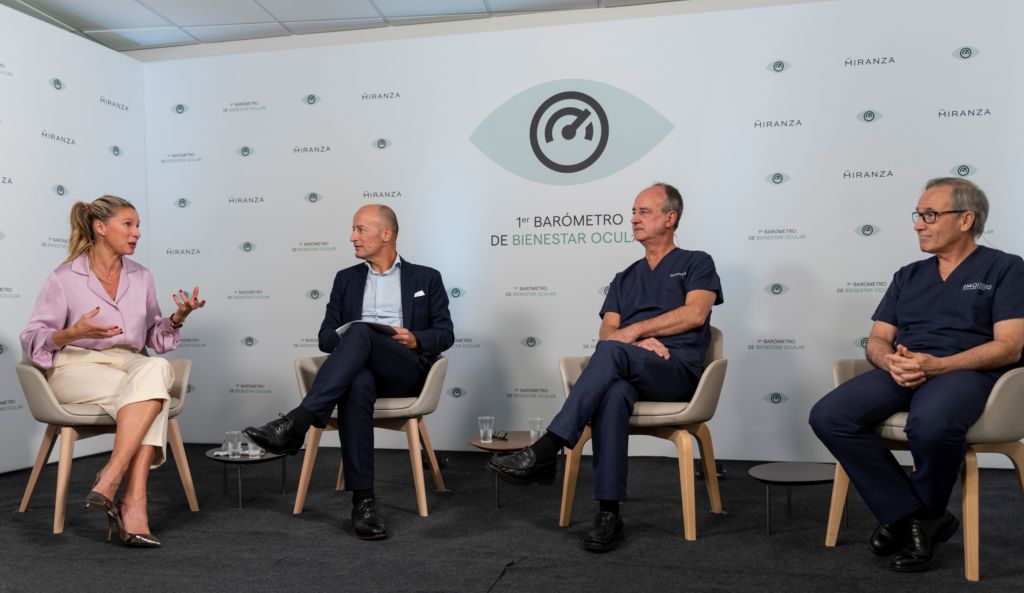Our current lifestyle, which is linked to technology and near vision, the main cause of eye discomfort
The first Miranza Eye Wellbeing Barometer highlights the importance of vision quality and not just quantity, with factors such as the fusion of images from both eyes, the dispersion of light as it passes through the eye or tears, among others
Our specialists interpret the data from the 1st Miranza Eye Wellbeing Barometer, after having surveyed more than 700 people and a hundred ophthalmologists.
The study, according to which 2 out of 3 Spaniards believe their vision is fair or poor, has shown that age is a crucial factor. In this regard, Dr Francisco Poyales, at Miranza IOA, states that “in terms of satisfaction with one’s visual condition, 45 years of age marks a turning point, as this is when many people begin to notice that they do not see as well as before, due to the appearance of presbyopia or eyestrain at a life stage that is still very active and visually demanding”. Especially from the age of 40 onwards, it is important to keep an eye on the evolution of vision and to take care of eye wellbeing by means of check-ups that make it possible to detect pathologies that become increasingly prevalent as the years go by.
Screen abuse and its relation to eye discomfort
Another handicap for eye wellbeing is, according to the results of the 1st Eye Wellbeing Barometer, the heavy use we make of screens (40% of those surveyed exceed 8 hours a day). Dr Ricardo Pérez, a specialist at Miranza IOA, explains that “this translates into an increase or worsening of dry eye cases by reducing the frequency of blinking, which decreases by 30% when we are in front of technological devices. Their use also causes problems with focusing and binocularity (the ability to merge the images of both eyes), leading to blurred vision, transient double vision, dizziness…”
Furthermore, a lifestyle linked to technology is often associated with an excess of near vision to the detriment of the distance vision we use when we engage in outdoor activities, which only 7% of those surveyed highlighted as a priority. Especially in the case of children and young people, this overexertion of the eyes at short distances can contribute to a gradual development of myopia, which is on the rise among new generations, as sustained by ophthalmologists.
Vision quality: which factors are involved?
When assessing eye wellbeing, Miranza specialists stress that it is not enough to measure visual acuity (the amount of vision), but that other factors which affect the quality of vision must also be analysed. According to Dr Blanca Poyales, also a specialist at Miranza IOA, “the quality of vision can be influenced by factors, such as the dispersion of light within the eye, which we can measure using specialised diagnostic tests, such as the OQAS (Optical Quality Analysis System)”. This problem usually increases as we age and can be associated with diseases, such as cataracts, leading to a loss of contrast and more glare.
The importance of tears to prevent eye discomfort
Tears also play a key role in visual quality, which, as Dr María Teresa Iradier at IMO Grupo Miranza points out, “is the first sign of eye health, as a healthy tear film allows us to see well and without discomfort”. In this regard, it is not only important to assess how much tear film the eye produces, but also how stable it is, i.e. whether or not it evaporates too quickly from the eye surface, which depends on the fatty part or lipid layer it is made of. Depending on the origin of dry eye, there are many solutions that can currently be offered to patients, for which Miranza features specialised departments.
Doing without glasses
Customised treatments to address both the pathological causes and the patients’ eye wellbeing in a comprehensive manner are also reflected in the techniques that reduce dependence on glasses or contact lenses on a daily basis. This is the limitation that most bothers a large part of the population, according to 54% of those surveyed, and refractive surgery as well as cataract surgery make it easier to do without optical correction. “This results in a greater sense of freedom and comfort in outdoor activities, sports or even at a romantic dinner to be able to read the menu”, emphasises Dr Javier Mendicute at Miranza Begitek, who adds that “for this reason, when indicating surgery, we take into account the characteristics of the eye, but also each person’s age, profession, hobbies, etc.”.

Avoiding eye discomfort: nine essential recommendations
In addition to analysing some of the main conclusions of the 1st Eye Wellbeing Barometer, our ophthalmologists have also summarised nine key recommendations to protect eye wellbeing and encourage prevention.
- Regular eye check-ups, especially for those over 45
- Pay attention to family history
- Adhere to treatments and do not postpone them (neither surgical nor pharmacological)
- Take breaks from viewing the screen and increase outdoor activity
- Good habits: sleep, good nutrition, exercise and no smoking
- Correct use and maintenance of contact lenses
- Use of preservative-free eye drops to moisturise the ocular surface
- Care for environmental conditions: light level, air conditioning, heating, etc.
- Use sunglasses with approved lenses